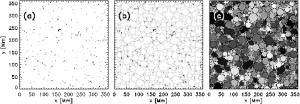
The large-scale magnetic pattern observed in the photosphere of the quiet Sun is dominated by the magnetic network. This network, created by photospheric magnetic fields swept into convective downflows, delineates the boundaries of large-scale cells of overturning plasma and exhibits “voids” in magnetic organization. These voids include internetwork fields, which are mixed-polarity sparse magnetic fields that populate the inner part of network cells.
To single out voids and to quantify their intrinsic pattern we applied a fast circle-packing-based algorithm to 511 SOHO/MDI high-resolution magnetograms acquired during the unusually long solar activity minimum between cycles 23 and 24. The computed void distribution function shows a quasi-exponential decay behavior in the range 10–60 Mm. The lack of distinct flow scales in this range corroborates the hypothesis of multi-scale motion flows at the solar surface. In addition to the quasi-exponential decay, we have found that the voids depart from a simple exponential decay at about 35 Mm.
more at: http://www.aanda.org/articles/aa/full_html/2014/08/aa24026-14/aa24026-14.html




More Stories
Stage a Tor Vergata: Summer 2019
A night at the University.
ESCAPE Project Press Release